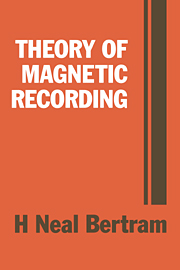Book contents
- Frontmatter
- Contents
- Preface
- 1 Overview
- 2 Review of magnetostatic fields
- 3 Inductive head fields
- 4 Medium magnetic fields
- 5 Playback process: Part 1 – General concepts and single transitions
- 6 Playback process: Part 2 – Multiple transitions
- 7 Magnetoresistive heads
- 8 Record process: Part 1 – Transition models
- 9 Record process: Part 2 – Non-linearities and overwrite
- 10 Medium noise mechanisms: Part 1 – General concepts, modulation noise
- 11 Medium noise mechanisms: Part 2 – Particulate noise
- 12 Medium noise mechanisms: Part 3 – Transition noise
- References and bibliography
- Index
2 - Review of magnetostatic fields
Published online by Cambridge University Press: 02 February 2010
- Frontmatter
- Contents
- Preface
- 1 Overview
- 2 Review of magnetostatic fields
- 3 Inductive head fields
- 4 Medium magnetic fields
- 5 Playback process: Part 1 – General concepts and single transitions
- 6 Playback process: Part 2 – Multiple transitions
- 7 Magnetoresistive heads
- 8 Record process: Part 1 – Transition models
- 9 Record process: Part 2 – Non-linearities and overwrite
- 10 Medium noise mechanisms: Part 1 – General concepts, modulation noise
- 11 Medium noise mechanisms: Part 2 – Particulate noise
- 12 Medium noise mechanisms: Part 3 – Transition noise
- References and bibliography
- Index
Summary
Introduction
Chapter 2 provides a review of basic electromagnetic theory as applied to static magnetic fields. Neither wave motion nor eddy current effects caused by conductive media are considered: it is presumed that all time scales are long compared to these phenomena. Time enters only through the constant head-to-medium relative speed, v, so that all temporal information is transformed immediately into the fundamental spatial recording process by x = vt or dx/dt. The purpose of this chapter is to provide useful relations for the determination of fields, both from integrals over field sources and solutions of differential equations for field potentials. Thus, the framework will be provided for the determination of magnetic fields from magnetized heads (Chapter 3) and media (Chapter 4), and in addition, expressions for Fourier and Hilbert transforms will be presented for utilization in spectral analysis of recording signals and noise. These transforms involve operations on the spatial variable, x, which represent the head-to-medium motion direction. In particular, the Fourier transform will be expressed in terms of the spatial transform variable, k: the wavenumber or inverse wavelength (2π/λ). For direct correspondence with measured frequency the simple transformation f = vκ/2π can be utilized.
In magnetic recording the track width is generally large with respect to dimensions in the nominal recording plane, which includes the head-to-tape motion direction and the direction perpendicular to the medium surface (thickness direction). Therefore, two-dimensional field expressions are useful and will be given explicitly in this chapter. In two dimensions the Fourier transforms acquire a particularly simple form yielding the familiar exponential spacing loss.
- Type
- Chapter
- Information
- Theory of Magnetic Recording , pp. 17 - 47Publisher: Cambridge University PressPrint publication year: 1994
- 1
- Cited by



